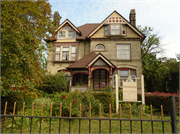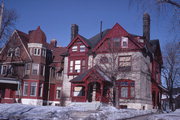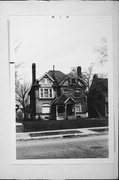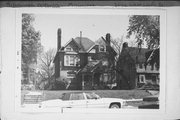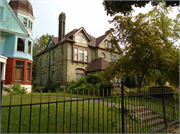Property Record
3026 W WELLS ST
Architecture and History Inventory
| Historic Name: | David W. Howie House |
|---|---|
| Other Name: | MANDERLEY BED AND BREAKFAST INN |
| Contributing: | |
| Reference Number: | 42032 |
| Location (Address): | 3026 W WELLS ST |
|---|---|
| County: | Milwaukee |
| City: | Milwaukee |
| Township/Village: | |
| Unincorporated Community: | |
| Town: | |
| Range: | |
| Direction: | |
| Section: | |
| Quarter Section: | |
| Quarter/Quarter Section: |
| Year Built: | 1886 |
|---|---|
| Additions: | |
| Survey Date: | 1984 |
| Historic Use: | house |
| Architectural Style: | Queen Anne |
| Structural System: | Balloon Frame |
| Wall Material: | Cream Brick |
| Architect: | C.f. Ringer |
| Other Buildings On Site: | |
| Demolished?: | No |
| Demolished Date: |
| National/State Register Listing Name: | Howie, David W., House |
|---|---|
| National Register Listing Date: | 1/16/1986 |
| State Register Listing Date: | 1/1/1989 |
| National Register Multiple Property Name: | Multiple Resources of West Side Area |
| Additional Information: | A 'site file' exists for this property. It contains additional information such as correspondence, newspaper clippings, or historical information. It is a public record and may be viewed in person at the Wisconsin Historical Society, State Historic Preservation Office. DESCRIPTION: The David W. Howie House is a high style Queen Anne residence. It is two stories with an attic level and sits on a foundation of rock-faced, coursed ashlar limestone. It is a large scale asymmetrical house and its plan centers on a massive rectangular block with a steeply pitched hip roof. The Howie House is of frame construction and the exterior is sheathed in Milwaukee cream brick. Wood is used extensively as trim in the gable ends, window tratments and the from porch. The brick is laid in common bond. The architectural character of this structure is derived from its decoration and detailing. The front porch has a steeply pitched hip roof and an overhanging entry gable that is inset with wood spindle work. The porch is supported by turned and incised posts. The double leaf paneled entry doors are sheltered by the porch. The windows in general are wooden, double-hung and fixed sash that are of various configurations. On the first floor, the windows flanking the front porch are set in arched openings with transoms and segmental brick lintels. On the second floor is an elaborate lunette with intricate Queen Anne stained glass. In the attic level the gable ends are highly decorated with wood shingels, fish scale shingling and sunburst panels. All of the elements combine to produce an elegant, but restrained Queen Anne design. The Howie House is located in what was once a gracious neighborhood of upper class 19th century housing. The house is sited on the front one-third of the 55 x 250 foot lot, with an ample front yard and a spacious backyard. There is little landscaping. Changes to the Howie House have been minimal. The exterior is virtually intact with little or no change to the form, design and details. The building is in excellent condition. ARCHITECTURAL/ENGINEERING SIGNIFICANCE: The David W. Howie House is locally significant as a fine example of Queen Anne style residential architecture. Although no architect has been attributed to its design, the Howie House demonstrates a clear understanding of Queen Anne design principles suggesting that an accomplished architect or master builder was involved in its design. In the context of Queen Anne houses in Milwaukee, the Howie House compares favorably with the city's finest examples. HISTORICAL STATEMENT: David Howie was an agent for the Northwest Fuel Company, a wholesale and retail coal dealer. He lived in this house from 1886 to 1897 when he moved to Elm Grove in rural, Waukesha County. The Howie House was one of the major residences built along this part of Wells Street when it was a fashionable new upper middle class residential street. Original construction cost was $10,000. Howie could commute to his downtown office via the West Side Railway Company's Wells Street horsecar line. (A, B, C). |
|---|---|
| Bibliographic References: | A. Milwaukee City Directories, 1885-1898. B. Milwaukee Blue Books, 1892-1911. C. Gurda, John. "The West End." Milwaukee: Milwaukee Humanities, University of Wisconsin Board of Regents, 1980, p. 92. Milwaukee Sentinel 11/15/1886, 8/2. MILWAUKEE HISTORIC BUILDINGS TOUR: WEST END, CITY OF MILWAUKEE DEPARTMENT OF CITY DEVELOPMENT, 1994. MILWAUKEE JOURNAL SENTINEL 6/9/1996. Spaces & Traces Open House Tour, Historic Milwaukee Inc., 2012. |
| Wisconsin Architecture and History Inventory, State Historic Preservation Office, Wisconsin Historical Society, Madison, Wisconsin |

